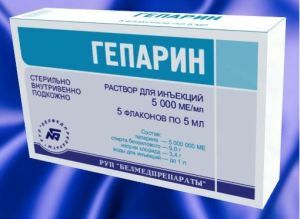 Anticoagulants are chemicals that can change the blood viscosity of , in particular to inhibit coagulation processes.
Anticoagulants are chemicals that can change the blood viscosity of , in particular to inhibit coagulation processes.
Depending on the group of anticoagulant, it affects the synthesis of certain substances in the body, responsible for the viscosity of blood and its ability to thrombogenesis.
There are anticoagulants direct and indirect action .Anticoagulants can be either in the form of tablets, or in injections and ointments.
Some anticoagulants are able to act not only in vivo, that is, directly in the body, but also in vitro - to show their abilities in a test tube with blood.
content
- Anticoagulants in medicine
- action of drugs of the body
- Direct anticoagulant
- indirect action Medication
- Classification anticoagulants
- Indications
- Contraindications
- group of drugs Anticoagulants direct
- Indirect anticoagulants
- Antiaggregants
- application features
- Conclusions
Anticoagulants in medicine
What is anticoagulants in medicine and what place do they occupy?
Anticoagulant, as a medicine, appeared after the 1920s, when dicumarol, an anticoagulant of indirect action, was discovered. Since then, studies of this substance and others have begun that have a similar effect.
Because of this, after certain clinical studies, drugs based on such substances have been used in medicine and carry the name of anticoagulants.
The use of anticoagulants is not intended solely for the treatment of patients.
Because some anticoagulants have the ability to exert their effect in vitro, they are used in laboratory diagnostics, in order to prevent coagulation of blood samples. Anticoagulants are sometimes used in deratization.
Effect of group drugs on the body
Depending on the group of anticoagulant, its effect is slightly different.
Straight anticoagulants
The main effect of direct anticoagulants is in inhibition of the formation of thrombin .Inactivation of factors IXa, Xa, XIa, XIIa, as well as 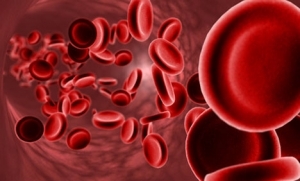 kalelecrine occurs.
kalelecrine occurs.
The activity of hyaluronidase is inhibited, but the permeability of the vessels of the brain and kidneys increases.
Also, along with this, the level of cholesterol, beta-lipoproteins decreases, lipoprotein lipase activity increases, the interaction of T and B lymphocytes is suppressed. Many direct-acting anticoagulants require INR control and other checks of blood clotting capacity to avoid internal bleeding.
Indirect Drug Medications
Indirect anticoagulants have the property of to inhibit the synthesis of prothrombin, proconvertin, a kristmas factor and a stewart-pre-factor in the liver.
The synthesis of these factors depends on the level of vitamin K1 concentration, which has the ability to transform into an active form under the influence of epoxy reductase. Anticoagulants can block the production of this enzyme, which leads to a decrease in the production of the above coagulability factors.
Classification of anticoagulants
Anticoagulant drugs are divided into two main subgroups:
- direct:
- indirect.
Their difference is that indirect anticoagulants act on the synthesis of collateral enzymes regulating blood coagulability, such drugs are effective only in vivo. Straight anticoagulants can act directly on thrombin and dilute blood in any carrier.
In turn, direct anticoagulants are divided into:
- heparins;
- low molecular weight heparins;
- hirudin;
- sodium hydrocitrate;
- lepirudin and danaparoid.
Indirect anticoagulants include substances, such as:
- monocoumarins;
- indandiones;
- dicoumarins.
They lead to competitive antagonism with vitamin K1.In addition to breaking the vitamin K cycle and inhibiting epoxy reductase activity, it is also assumed that they inhibit the production of quinone reductase.
There are also substances similar to anticoagulants, which by other mechanisms reduce blood clotting. For example, sodium citrate, acetylsalicylic acid, sodium salicylate.
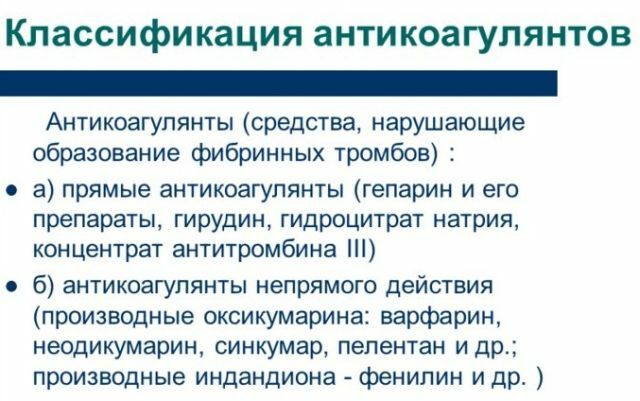
indirect and direct anticoagulant classification
Indications for use
Anticoagulants are used in almost all cases where there is a risk of thrombus formation in cardiological diseases and diseases of the vessels of the extremities.
In cardiology, is assigned with:
- of congestive heart failure;
- presence of mechanical heart valves;
- chronic aneurysm;
- arterial thromboembolism;
- parietal thrombosis of the heart cavities;
- large-heart attack myocardial infarction.
In other cases, anticoagulants are intended for the prevention of thrombosis:
- thrombophlebitis of the veins of the lower extremities;
- varicose veins;
- postpartum thromboembolism;
- long stay in bed after surgery;
- blood loss( over 500 ml);
- cachexia,
- prevention of reocclusion after angioplasty.
 What is meant by the prevention of thrombophlebitis and what methods and methods are used you can learn from our article.
What is meant by the prevention of thrombophlebitis and what methods and methods are used you can learn from our article. If you are prescribed Vasobrail, the instructions for use are mandatory. All that you need to know about the medicine is contraindications, reviews, analogues.
Contraindications to the use of drugs group
He must pass a general blood test, a general urine test, a Nechiporenko urine test, a fecal occult blood test, a biochemical blood test, and coagulogram and ultrasound of the kidneys.
Anticoagulants are contraindicated in the following diseases:
- intracerebral aneurysm;
- peptic ulcer of the gastrointestinal tract;
- Vitamin K hypovitaminosis;
- portal hypertension;
- thrombocytopenia;
- leukemia;
- malignant tumors;
- renal or hepatic insufficiency;
- high blood pressure( above 180/100);
- alcoholism;
- Crohn's disease.
Direct-acting anticoagulants
The main representative of direct anticoagulants is heparin .In its composition, heparin has chains of sulfated glycosaminoglycans of various sizes.
Bioavailability of heparin is low enough for adequate dosing of the drug. This primarily depends on the fact that heparin interacts with many other substances in the body( macrophages, plasma proteins, endothelium).
Therefore, treatment with heparin does not exclude the possibility of a thrombus. It should also be taken into account that the thrombus on the atherosclerotic plaque is not sensitive to heparin.
There are also low molecular weight heparins: enoxaparin sodium, deltaparin sodium, supraparin calcium. 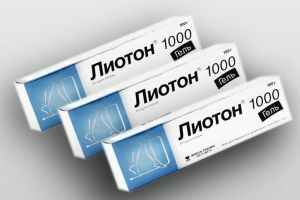
However, that they have a high antithrombotic effect due to high bioavailability( 99%), such substances are less likely to cause hemorrhoidal complications. This is due to the fact that the molecules of low-molecular-weight heparin do not interact with the von Willebrand factor.
Scientists have tried to recreate synthetic hirudin - a substance that is in the saliva of leeches and has a direct anticoagulant effect, which lasts about two hours.
But the attempts were unsuccessful. Nevertheless, lepiridin was created - a recombinant derivative of hirudin.
Danaparoid is a mixture of glycosaminoglycans, which also has an anticoagulant effect. The substance is synthesized from the porcine intestinal mucosa.
Drugs representing oral anticoagulants and ointments direct action:
- Heparin in injections;
- Heparin ointment;
- Buckwheel;
- Lyoton Gel;
- Venolife;
- Xarelto;
- Clexan;
- Fluusum;
- Hepatrombin G;
- Venitan H;
- Trombleuss;
- Fragmin;
- Prolonged.
Indirect anticoagulants
Anticoagulants of indirect action are divided into three main types:
- monocoumarins;
- dicoumarins;
- indandiones.
Indirect anticoagulant preparations of this type are used by to reduce coagulation of blood for a long time.
One of the subgroups of these drugs has its effect due to a decrease in the liver of K-dependent factors( vitamin K antagonists).This includes factors such as: prothrombin II, VII, X and IX.Lowering the level of these factors leads to a decrease in the level of thrombin.
Another subgroup of indirect anticoagulants has the property of reducing the formation of proteins of the anticoagulant system( proteins S and C).The peculiarity of this method is that the effect on the protein occurs faster than on K-dependent factors.
And therefore these drugs are used when an urgent anticoagulant effect is needed.
Key representatives of anticoagulants indirect action:
- Syncumar;
- Neodikumarin;
- Fenindione;
- Warfarin;
- Fepromarone;
- Pellet;
- Azencumarol;
- Thrombopop;
- Ethyl biscumacetate.
Antiaggregants
These are substances that are able to reduce aggregation of platelets involved in thrombogenesis. Often used together with other drugs, enhancing and supplementing their effect. A vivid representative of the antiaggregant is acetylsalicylic acid( aspirin).
This group also includes anti-gout and vasodilator drugs, antispasmodics, and a blood substitute reopolyglucin.
Essential preparations:
- Aspirin. It leads to a breakdown in the metabolism of arachidonic acid.
- Ticlopidine. The drug is capable of cleaving FIF2( phosphatidylinositol-4, 5-diphosphate) and altering platelet aggregation.
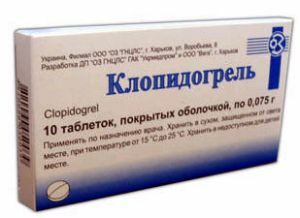
- Clopidogrel( thienopyridine).The structure is similar to ticlopidine, but the drug itself is less toxic.
- Tirofiban. Low molecular weight inhibitor of the glycoprotein IIb / IIIa. Has a short time of action.
- Dipyridamole. Vasodilator.
- Abciximab. It consists of Fab fragments of monoclonal antibodies to the glycoprotein IIb / IIIa. Has the property of binding to avβ3-integrin.
- Eptifybatite. A cyclic peptide disrupts the aggregation of platelets.
Application features of
In medical practice, antiplatelet agents are used in parallel with other anticoagulants , for example with heparin.
In order to obtain the desired effect, the dosage of the preparation, and the preparation itself, is chosen such that to level or, on the contrary, enhance the action of another anticoagulant.
The onset of antiplatelet action occurs later than in simple anticoagulants, especially direct action. After the abolition of such drugs, they are not removed from the body for some time and continue their action.
Conclusions
Since the middle of the twentieth century, in practical medicine, new substances have been used that can reduce the blood's ability to form a thrombus.
It all started when cows started dying in one settlement from an unknown disease, in which any wounding of cattle led to his death, due to non-stop bleeding.
Scientists later found out that they used the substance - dicumarol. Since then the epoch of anticoagulants has begun. During which millions of people were saved.
Currently, more universal products are being developed that have the minimum number of side effects and have the maximum efficiency.
